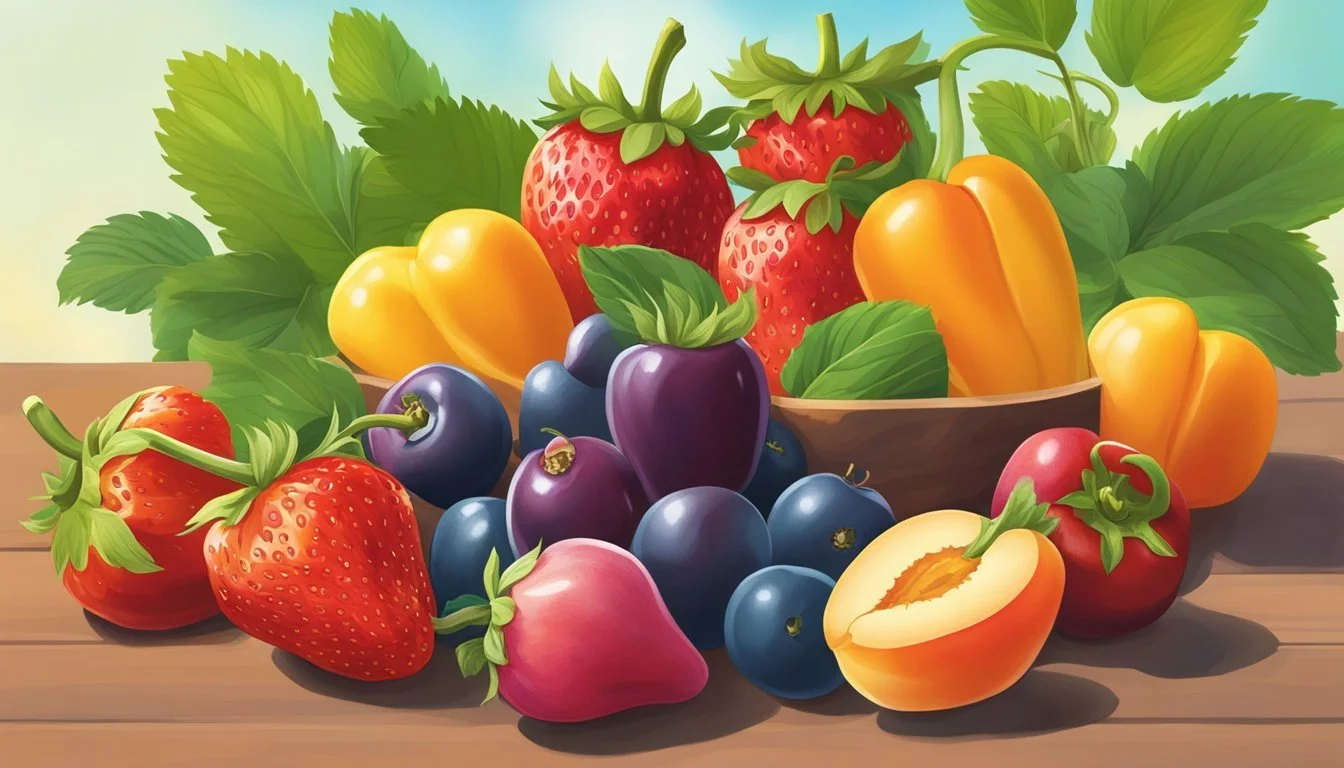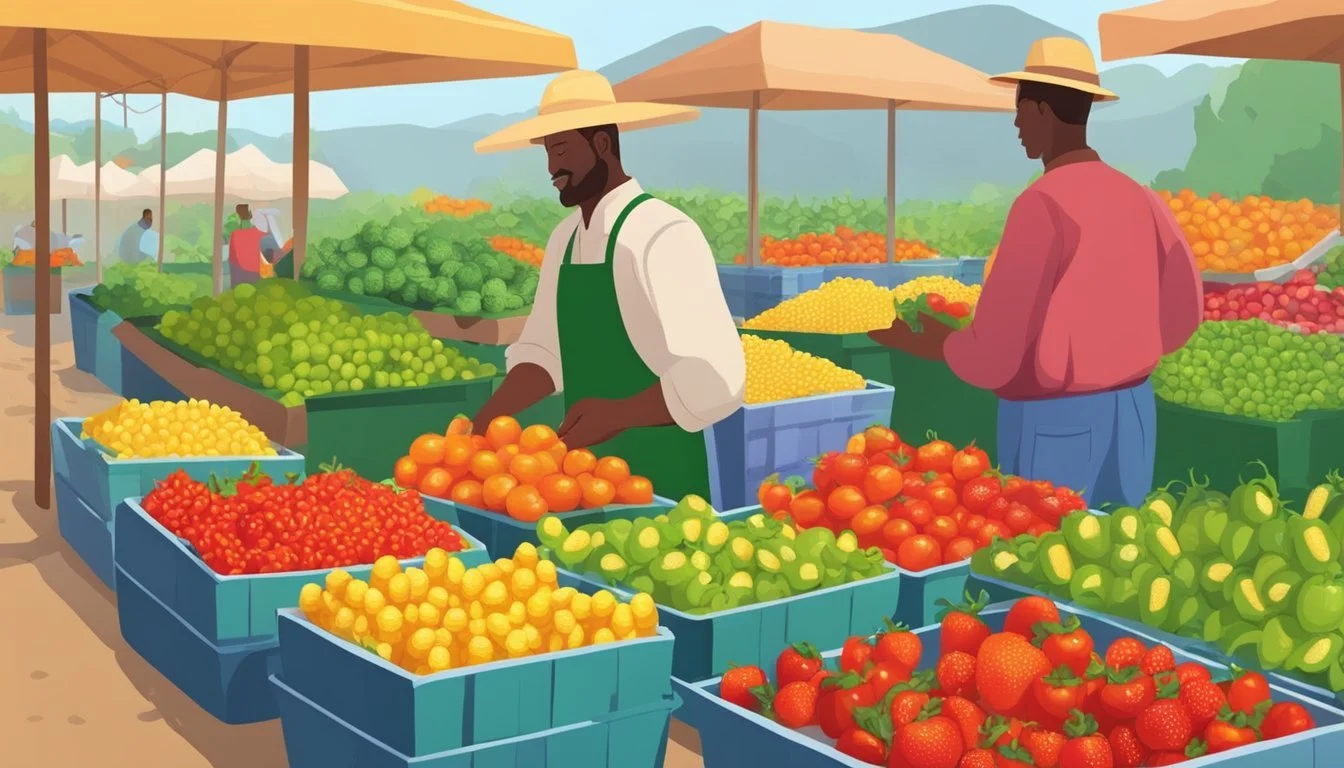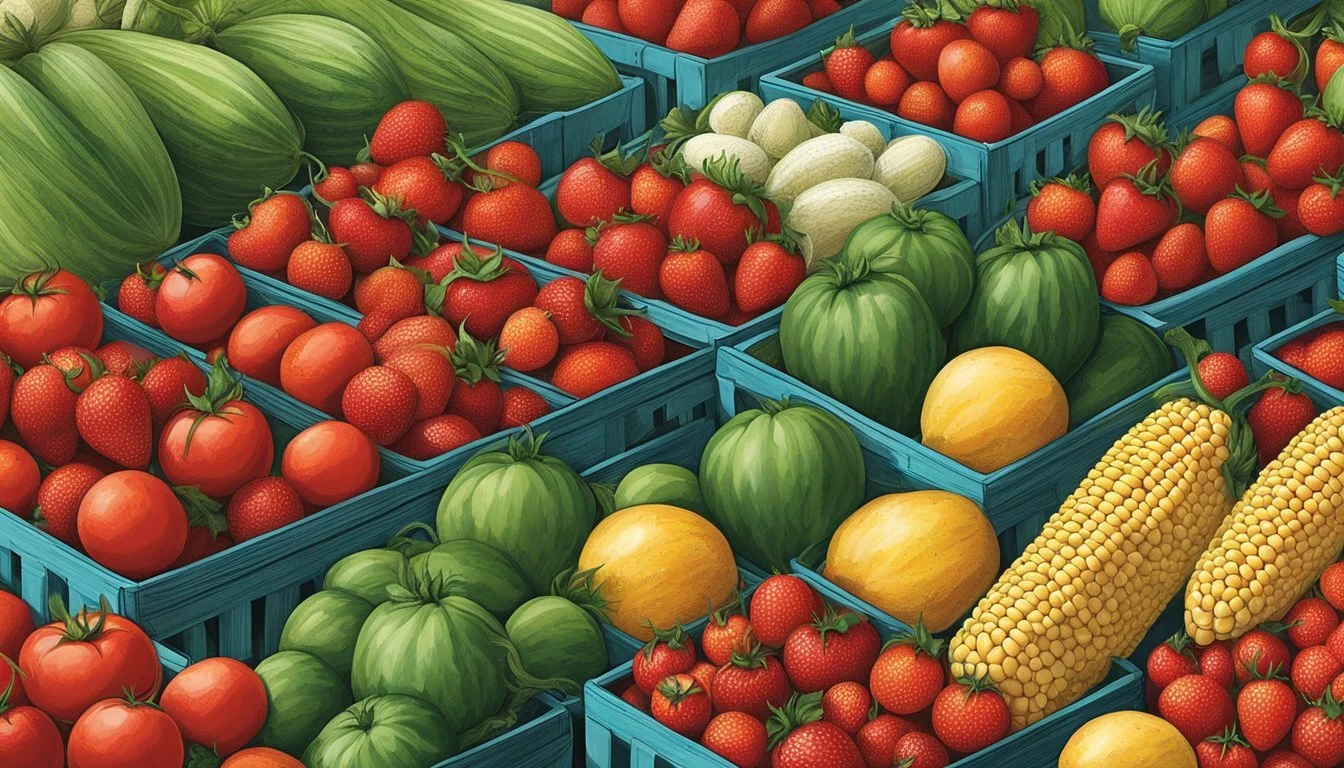South Dakota Seasonal Fruit & Vegetables in July
Your Month's Guide
This Article is Part of our South Dakota Seasonal Fruit & Veg Calendar
In July, South Dakota's landscape thrives with the bounty of summer, offering a variety of seasonal fruits and vegetables. The warm climate and fertile soil create an ideal growing environment for numerous crops during this peak season. Residents and visitors alike have the opportunity to enjoy the fresh produce that local farmers harvest, with markets brimming with vibrant colors and rich flavors.
The selection of available produce in South Dakota during July includes a rich array of fruits such as raspberries, blackberries, and cherries (how long do cherries last?), reflective of the season's sweetness. Vegetables also take a stand in abundance, with staples like cucumbers (how long do cucumbers last?), peppers, and tomatoes reaching their peak freshness. The summer month not only invites ample sunlight for flourishing gardens but also encourages outdoor activities like fruit picking and visiting farmers' markets, adding to the enjoyment of seasonal eating.
While the grocery stores provide produce year-round, there is a distinct difference in the taste and nutritional value of farm-fresh, in-season offerings. This period is also an excellent time for South Dakota residents to support local agriculture and partake in the rich agricultural heritage of the state. Seasonal harvests promise not just great flavors but also a connection to the local land and its seasonal rhythms.
Overview of South Dakota's Seasonal Produce
In July, South Dakota's produce selection reflects its summer climate and diverse agricultural zones. The state's favorable conditions bring a variety of fruits and vegetables to their peak season.
Climate and Agriculture
South Dakota's climate varies significantly, with the eastern part experiencing humid continental weather, and the western part having a semi-arid climate. Summer is particularly favorable for agriculture, with warm temperatures that allow a wide range of produce to flourish. During this month, the long, sunny days contribute to the ripening of many fruits and vegetables, making it a bustling time for farmers and markets.
Hardiness Zones and Growing Season
The state falls into several hardiness zones, ranging from zones 3 to 5. These zones indicate the region's growing season and the types of crops that can withstand the local winter temperatures. In South Dakota, the growing season starts in spring and extends into fall, with July being a pivotal month as many crops reach their maturity and are ready for harvest.
Peak Seasonality for Fruits and Vegetables
During July, South Dakota enjoys the height of its harvesting season for various fruits and vegetables. Here are some examples:
Fruits: July marks the availability of fruits like raspberries and cherries.
Vegetables: The warmer temperatures make it an ideal time for vegetables such as cucumbers, snap peas, and green beans.
It should be noted that while most produce is in season, the availability can vary depending on the specific regional climate and current weather conditions.
July Harvest Calendar for South Dakota
In July, South Dakota's rich soil and warm weather contribute to the ripening of a variety of fruits and vegetables. The peak harvest times present an ideal opportunity for fresh produce consumption.
Fruits in Season
Strawberries: The last of the strawberries are typically harvested in early July.
Rhubarb: Rhubarb remains available in July, although nearing the end of its season.
Vegetables in Season
Tomatoes: July marks the beginning of tomato season, with early varieties coming into harvest.
Bell Peppers (What wine goes well with bell peppers?): Bell peppers start to ripen and are picked during this month.
Cucumbers: Cucumbers are ready for harvest throughout July.
Beans: Various bean types, including snap beans, are in season.
Peas: Early July still offers fresh garden peas before the season ends.
Carrots: Carrots continue to thrive and can be harvested this month.
Selecting and Storing Fresh Produce
When it comes to enjoying the bounty of July fruits and vegetables in South Dakota, knowing how to select the ripest produce and store it correctly is key to maintaining flavor and nutrition.
Tips for Choosing Ripe Fruits and Vegetables
Visual Inspection: Look for fruits and vegetables that have vibrant colors, which typically indicate ripeness and peak flavor. For example, tomatoes should be a deep red without any green spots, and peppers should have a glossy exterior.
Touch: Gently squeeze the produce; ripe fruits and vegetables should yield slightly under pressure but shouldn't be too soft or mushy.
Smell: Ripe fruits often emit a sweet and pronounced aroma. For instance, a ripe melon will have a fragrant scent at the stem end.
Best Practices for Storage
Refrigeration: Certain produce items should be stored in the fridge to extend freshness. Leafy greens, for example, maintain their crispness and nutrition when kept in a crisper drawer.
Temperature: Keep your fridge temperature between 35°F and 40°F to prevent spoilage.
Humidity: Use high humidity settings for leafy produce and low humidity for fruits prone to moisture.
Countertop Storage: Some produce like tomatoes develop their best flavor when stored at room temperature, away from direct sunlight.
Separation: Ethylene-producing fruits such as apples can cause other produce like potatoes to spoil faster; they should be stored separately.
Gardening Advice for July
In July, South Dakota gardeners face the height of summer with specific challenges and opportunities. They must consider the warm weather and strive for a successful harvest before the first frost arrives.
What to Plant in July
Vegetables:
Lettuce: Varieties such as Butterhead, Boston, and Loose Leaf can be planted. They are cold hardy and can withstand light snow and frost.
Late Harvest Vegetables: Plant seeds that will yield produce into the late fall months.
Herbs:
Considering the region's climate, gardeners should opt for herbs that can tolerate the summer heat while benefiting from the cooler evenings.
Garden Maintenance Tips
Pruning:
Trees and Shrubs: Remove damaged branches to prevent hazards during thunderstorms and maintain desired plant shapes.
Fruit Trees: Pruning facilitates better light penetration and air circulation, which are critical for fruit set and ripening.
Soil and Watering:
Ensure soil retains moisture but drains well to prevent root rot and diseases.
Water plants deeply and less frequently to encourage strong root development.
Pest Management:
Regularly check for pests and address infestations promptly to protect the garden's health.
Note on Weather and Frost:
Monitor local weather forecasts; if temperatures exceed 95 degrees Fahrenheit during the day, the production and ripening of fruit, such as tomatoes, may be adversely affected.
Be mindful of the average first frost date to optimize planting times and protect sensitive plants.
Healthy Eating and Nutrition
In July, South Dakota's agriculture offers a diverse palette of fruits and vegetables ripe for the season. Embracing these seasonal offerings can enhance one's diet with fresh, nutrient-dense choices that support overall health and wellness.
Benefits of Seasonal Eating
Consuming fruits and vegetables during their peak season can offer improved taste and higher nutritional value. Items like berries and leafy greens are more flavorful and packed with vitamins when harvested at the right time. Seasonal eating also contributes to a varied diet, ensuring one gets a wide range of nutrients essential for good health.
Taste: Seasonal produce is fresher and generally tastes better.
Nutritional Value: Produce is most nutrient-dense when consumed in season.
Recipe Ideas with July Produce
Incorporating seasonal fruits and vegetables into recipes can be both delicious and healthy. For example, an individual can enjoy a crisp salad using freshly picked South Dakota greens, topped with an array of berries for added antioxidants and flavor.
Salad: Fresh greens and berries, tossed with a light vinaigrette.
Grilled Vegetables: (What wine goes well with grilled vegetables?) Seasonal vegetables like bell peppers and zucchini, grilled for a smoky flavor.
By utilizing July's seasonal offerings in various recipes, one not only enjoys a burst of flavor but also maximizes the nutritional benefits of their meals, contributing to a healthy eating pattern.
Supporting Local Agriculture
In South Dakota, supporting local agriculture in July means embracing the bounty offered by regional farmers and cultivators. Shopping at farmers' markets and participating in Community Supported Agriculture programs are two significant ways individuals can contribute to the local economy and obtain fresh, in-season produce.
Finding Farmers' Markets
Farmers' markets across South Dakota serve as vital platforms for local farmers to sell their fresh produce directly to consumers. They are widespread throughout the state and provide an array of fruits and vegetables that are at their peak in July. Consumers can find markets in various locations from small towns to the larger cities. Resources such as the South Dakota Department of Agriculture website offer directories for locating these markets, facilitating consumers in supporting local growers and enjoying seasonal crops.
Sioux Falls: Saturdays, 8 a.m. - 1 p.m. at Falls Park
Rapid City: Saturdays, 9 a.m. - 1 p.m. at Main Street Square
Community Supported Agriculture (CSA)
Community Supported Agriculture (CSA) programs are a partnership between local farms and consumers in the United States where individuals purchase a share of the harvest in advance. This pre-season investment helps farmers cover the initial annual costs of the farm operations. In return, members receive a regular supply of fresh fruits and vegetables throughout the growing season. CSAs in South Dakota typically offer a variety of produce that could include items like:
Tomatoes
Sweet corn
Peppers
Greens
The state fosters a strong CSA presence, ensuring consumers have access to fresh, seasonal food while supporting local agriculture through direct financial contribution.







